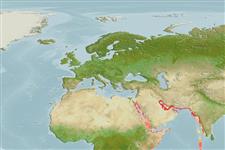Malacostraca |
Decapoda |
Sesarmidae
Environment: milieu / climate zone / depth range / distribution range
Ecology
Benthic; brackish. Tropical
Western Indian Ocean: In the northwestern Indian Ocean from Arabian Gulf to the Gulf of Oman and Pakistan.
Length at first maturity / Size / Weight / Age
Maturity: Lm ? range ? - ? cm Max length : 0.9 cm CL male/unsexed; (Ref. 107481); 0.824 cm CL (female)
It is found on rocky intertidal areas, rocky jetties, oyster banks and mangroves (Ref. 106819). Some under artificial stones or old boats at the intertidal (Ref. 115228). Found on sediments of varying sizes. Lives in small burrows among pneumatophores, under decaying wood and large dead shells (Ref. 107481).
Life cycle and mating behavior
Maturity | Reproduction | Spawning | Eggs | Fecundity | Larvae
Naderloo, R. and M. Türkay 2012 Decapod crustaceans of the littoral and shallow sublittoral Iranian coast of the Persian Gulf: faunistics, biodiversity and zoogeography. Zootaxa 3374:1-67. (Ref. 106819)
IUCN Red List Status
(Ref. 130435: Version 2025-1)
CITES status (Ref. 108899)
Not Evaluated
Not Evaluated
Threat to humans
Harmless
Human uses
| FishSource |
Tools
More information
Trophic EcologyFood items (preys)
Diet composition
Food consumption
Predators
Population dynamicsGrowth
Max. ages / sizes
Length-weight rel.
Length-length rel.
Length-frequencies
Mass conversion
Abundance
Life cycleReproduction
Maturity
Fecundity
Spawning
Eggs
Egg development
Larvae
PhysiologyOxygen consumption
Human RelatedStamps, coins, misc.
Internet sources
Estimates based on models
Fishing Vulnerability
Low vulnerability (10 of 100).
